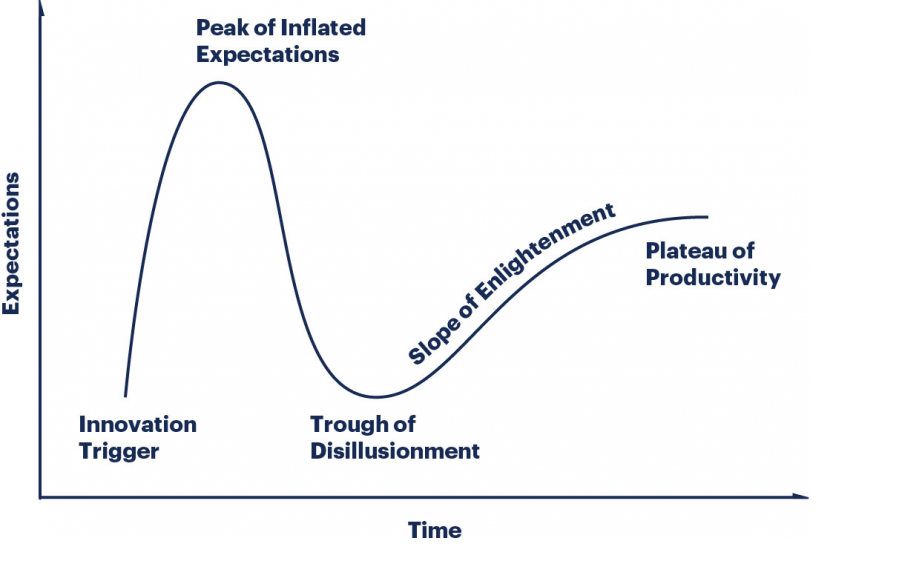Flying Cars and Remote Work
In the technology industry, there is a pithy aphorism that, “The future is already here - it’s just not evenly distributed.”
While the expression may seem a bit trite, from my experience, it is uncannily accurate. Because transformative technologies grow from a small (or non-existent base!) their significance is underestimated, or even ridiculed, and the speed with which they are adopted far surpasses expectations.
When the transformative nature of a technology is recognized, by at least some portion of the public or the market, expectations oftentimes grow even more rapidly than the technology itself and we end up with the classic Boom and Bust or “Gartner Hype” cycle.
Gartner Hype Cycle
After the initial peak of inflated expectations, the public and investors go back to underestimating and ridiculing the technology that just seemed so transformational in the recent past!
As an investor and builder, I want to identify and bet on technologies at their innovation trigger or at their trough of disillusionment. Troughs of disillusionment are easier to spot than innovation triggers because the peak of inflated expectations is oftentimes a full scale media event - think Bitcoin/Crypto in 2017 and 2021 or AI in 2023. When your friends and family, and Elon Musk, are all shilling Dogecoin, it likely means you are at the peak of inflated expectations and the trough of disillusionment is soon to follow. On the other hand, an innovation trigger could be completely hidden from the world in someone’s garage - the future is here, but it’s not easily knowable.
So, what technologies do I think are already here, but are unevenly distributed?
Flying Cars
“We wanted flying cars, instead we got 140 characters”
It’s a bit embarrassing to admit, but despite my interest in Peter Thiel’s thinking, I never seriously researched or read about flying cars as technology until reading a review of a book called “Where is Flying Car?” on Roots of Progress. That led me to read the full book in late 2021 and started my obsession with the newest instantiation of flying cars, eVTOLs (electric vertical takeoff and landing). The book goes into great detail about the Commuting Principle, and how the speed at which we can travel physical distances determines the shape and sizes of our cities. I’ll have to dive deeper into eVTOLs in a future post, but after reading the book and the Commuting Principle, and doing some napkin math, I believe that the future “eVTOL city“ could be 600x larger than the “car city”!
Illustration of how the size of cities expands with the speed of our transportation technologies.
As a result of my research, I invested in Joby Aviation back in April.
I hope that someday I’ll be able to have an eVTOL wisk me to Seattle in a mere 30 minutes instead of the 2.5 hour drive it takes today in a car.
Remote Work
Before Covid, remote work was just starting to gain traction in the technology industry, let alone other sectors of the economy. As a result of Covid, remote work became mandatory for a brief period of time. In the US, the share of days worked remotely went from around 5% to ~60%! Now, it’s around 30% and I am among the ~12% who work from home nearly 100% of the time.
So, if remote work is so highly adopted, how can this be an underestimated or unevenly distributed technology?
Well, I think of the brief surge to 60%+ WFH as being a forced “peak of inflated expectations”. Now, it feels like we’re in the trough of disillusionment phase. Why do I say this? WFH vs. RTO has been quite a polarizing topic in the tech industry with figures like Elon Musk saying “working from home is morally wrong” and David Sacks tweeting “It’s time to admit that Remote Work doesn’t work.” On the other hand, Brian Chesky, founder and CEO of Airbnb, has turned AirBnb into a fully remote company that allows its employees to work from anywhere without within-country pay disparity by job role.
The synthesis of their point-of-view is that remote work really does only work for Bits economy jobs with high accountability from exposure to market competition. With current technology, remote work is an extremely poor fit for an Atoms company like Tesla or monopolistic Bits economy companies with poor management practices like Google.
I suspect this is the reason why less than 30% of companies with more than 25k employees allow full remote work while nearly 90% of companies with less than 500 employees allow full remote work.
Startups and smaller companies as a whole are more innovative and grow faster than larger companies and so I would expect this to be one source of growth in remote work.
I believe the underestimated view is that with so much remote work happening in the economy, this is a huge incentive for companies to innovate and invent better remote work technologies. Yes, Zoom and Google Meet are fantastic remote work technologies compared to Skype or Google hangouts of 2010, but I really don’t think progress stops there. Live Share with Visual Studio Code and Google Docs are two instances of remote work being much more effective than the alternative (looking over someone’s shoulder as they code or write).
In my view, the killer use case for Augmented Reality and Virtual Reality is remote work. It’s not difficult to imagine that a sufficiently advanced Meta Quest or Apple Vision Pro will render realistic holograms of your family, friends, and coworkers and enable much more effective hybrid meetings and fully remote work collaboration. It’s also not hard to imagine in 5 or 10 years that these AR/VR headsets will be the size of a pair of sunglasses and cost no more than a smartphone.
This is my view and I am very much looking forward to trying out an Apple Vision Pro when they are available in the Apple Store.



